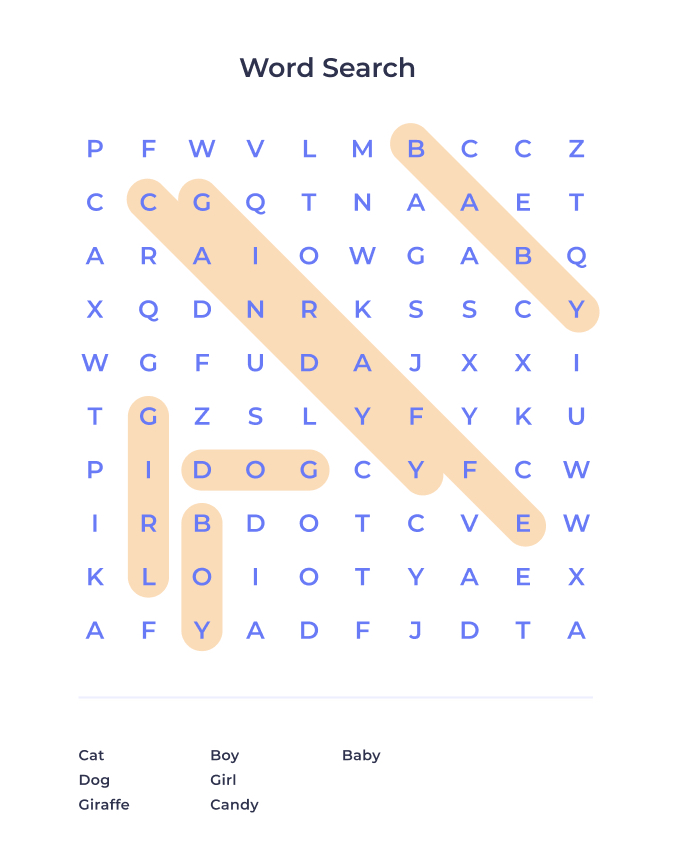Preview Worksheet


Log in
Frequently Asked Questions
As children grow older, they learn more advanced versions of the things they covered as basics. That is, except for their name – it’s the one thing they’ll need to write, as is, for a long, long time.
Whether it’s to sign legal documents in the future or write their name on a test, kids should start name tracing early on. Besides the obvious benefit, it helps them develop skills such as letter recognition and develop motor skills. This can help them learn other skills such as writing.
Name tracing is an important activity that develops many skills in the pre-writing phase. From the time a toddler doesn’t know how to hold a pencil, they start scribbling on paper and the walls.
This is the right time to introduce name tracing and develop your child’s writing skills. Name tracing helps a child learn to hold writing instruments, build muscle and hand coordination, and improve concentration.
Name tracing helps a toddler hold a pencil or crayon properly. When they trace their name, they develop writing skills. Furthermore, name tracing improves muscle and eye coordination in children. Since they know how to pronounce their name, they can easily learn individual letters.
If your child lacks the strength to trace names with their hand and fingers, you can use many other tools and techniques as well, such as a tracing board.
Name tracing is a good way to help children memorize letters and structure. You can use dot-to-dot letter tracing worksheets with your child’s name. This way, your child will memorize the letters in their name. A good way to help build letter recognition is to teach them how to write their friends’ names. Not to mention, they learn phonetics by pronouncing each letter.
Name tracing develops fine motor skills in children and helps them with other tasks as well. For instance, they can easily understand the structure of letters and relate those letters with items around them. Some other benefits of name tracing include improvement in:
- Dexterity
- Hand and eye coordination
- Spatial awareness
Also, name tracing is the foundation of learning to write letters and words and draw shapes. Here are some skills that your child can develop through name tracing.
1. Fine Motor Skills
Name tracing is an incredible technique to learn fine motor control. When it is time for children to learn how to write, they should understand its importance. Name tracing helps them understand that they can express their thoughts by hand. Since children have been hearing their names since the time they first opened their eyes, they may be curious as to know what it looks like, written. Thus, they should learn to write their name first.
Simple name tracing activities can build coordination and strength between wrists, fingers, and hands. They learn how to control their movements while tracing their name. The more they practice, the quicker they will learn to hold utensils and control their movements.
2. Pre-Writing Skills
When children trace the curves and lines of their names, they learn the structure of letters. This marks the beginning of writing letters. Name tracing can improve your child’s skills to write and draw. That’s because it refines coordination and movements that they should learn for writing. Some benefits of name tracing to build pre-writing skills include:
- Developing hand-eye coordination
- Gaining the ability and power to hold writing tools
- Developing a dominant hand
- Crossing the midline
3. Concentration and Focus
Building concentration and focus are crucial for children in the pre-writing phase. They can learn these skills using pencils and crayons to trace along the lines. But, since they don’t know the name of the items, they can’t connect to the process. However, when they start tracing their names on paper, they will feel confident, which builds concentration skills. In other words, name tracing develops attention and working memory.
4. Visual-Spatial Skills
Visual-spatial skills include the ability to sense. A child can develop such ability by connecting the dots on paper. Name tracing on paper can help your child connect as they pronounce their name. They learn the starting and ending positions of their name and connect the dots.
You can use these name tracing worksheet options:
· Arrow Tracing
The arrow tracing worksheet contains arrows as straight and curved lines. This helps a child understand what direction they should move a pencil in. For instance, if their name starts with B, the top to bottom arrow will direct them in the right direction. Then they can trace both the semi-circle to complete the letter B. With practice, they can start writing complete words that start with the letter B or any other letter. This is a simple and basic name tracing technique. This exercise is helpful for toddlers who don’t know how to trace a line.
· Dot-to-Dot
The dot-to-dot name tracing technique is useful to develop good writing habits. In this example, you print a worksheet with your child’s name. But, instead of tracing the lines, your child connects the dots. This technique will help your child draw straight lines and curves without making mistakes. The series of dots help your child to focus. It is an effective letter formation technique for children who can trace a printed line but can’t form a letter without support.
· Cursive Tracing
This type of worksheet helps children improve their penmanship. Since they learn how to trace their name with lines and dots, they can get more creative. Cursive name tracing improves writing speed neural correction and builds the ability to read cursive. It is suitable for children around three to four years.
Name tracing might be interesting for your child in the beginning, but with time, it can get boring. After all, your children won’t learn to trace their names overnight. It takes time for a child to develop motor and concentration skills. Thus, you need to keep these activities separate and more engaging than school activities. Here are some ways to make name tracing fun and interesting:
· Sandpaper Letters
Children love sandpaper exercises. The unique sensory experience gives them a feeling to associate with the letters. Name tracing on the sandpaper enhance their ability to trace in a particular order. You can stitch your child’s name on the sandpaper for name tracing. When children feel, read, and see the letters, they develop multi-sensory skills.
· Gel Bags
Gel sensory bags develop motor skills and a sense of touch. Not to mention, gel bags can be endless fun. Kids will love tracing their names on colorful gel bags. This activity is suitable for children above two years.
You can create these cool gel bags at home. Take a Ziploc bag and fill half of it with hair gel, along with a few drops of food coloring. You can use your child’s favorite colors. Now, write your child’s name on the page and place it above the paper. You kid will trace the letters and learn their name.
· Glittery Letters
Here is another fun and creative activity to help your child with name tracing. Take a stiff piece of cardboard and write your child’s name with a marker. Your children can use a glue stick to trace their names on the cardboard. Then, they can sprinkle some colorful glitter to cover the glue. When the glue dries, they can trace their name with their finger. This activity will develop motor as well as artistic skills. Since this activity can get a little messy, make sure to use some old newspaper under the cardboard to collect extra glitter.
There are more than five thousand unique and popular first names in the U.S. So, even if a child doesn’t have a unique name, there are numerous ways to spell some names. Therefore, you might find it difficult to find a worksheet that spells your child’s name properly.
Luckily, you can create a name tracing worksheet through a worksheet generator that is specifically designed for name tracing. The generator allows you to customize your child’s name and print the worksheet. That way, you can use both first and last names, even if your child has a unique or long name.
This worksheet generator replaces blank pages for name tracing. Also, when your children recognize their names, you can customize other names as well. For instance, you can generate their friend’s name and help them learn other letters.
These name tracing worksheet generators are easy to use. Here are the steps:
- Open the worksheet generator
- Type your child’s name. Use capital letters in the beginning so your child can easily identify the letters.
- Insert how many times the name should appear on the worksheet.
- You can also include the names of family and friends to give them a variety of letters.
Name tracing is a beneficial activity to help your child refine fine motor skills, boost concentration, and build confidence. This activity has a wide range of cognitive benefits, which help children to recognize letters, learn writing, and identify the spelling of their name.
It is easier for a child to write their name than the name of other items. Furthermore, they will feel proud of their name. There are many other benefits of name tracing as well. This includes building muscle memory, developing writing habits, and building wrist strength.





